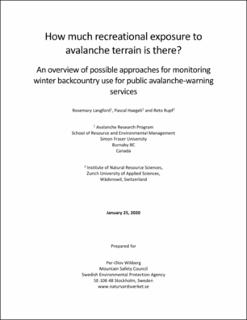Please use this identifier to cite or link to this item:
https://doi.org/10.21256/zhaw-25350Full metadata record
| DC Field | Value | Language |
|---|---|---|
| dc.contributor.author | Langford, Rosemary | - |
| dc.contributor.author | Haegeli, Pascal | - |
| dc.contributor.author | Rupf, Reto | - |
| dc.date.accessioned | 2022-07-27T08:41:00Z | - |
| dc.date.available | 2022-07-27T08:41:00Z | - |
| dc.date.issued | 2020-01 | - |
| dc.identifier.uri | https://digitalcollection.zhaw.ch/handle/11475/25350 | - |
| dc.description.abstract | Winter backcountry mountain sport operators, outdoor mountain recreation industry experts, and researchers in Europe and North America commonly report that participation in winter backcountry recreation in mountainous terrain has increased tremendously in recent decades. While increasing numbers of backcountry skiers, mountain snowmobile riders, snowshoers, ice climbers, and mountaineers venture into the backcountry, these activities are not without risks. The primary hazard faced by winter backcountry recreationists is snow avalanches. Every winter over the last decade, between 125 and 150 backcountry recreationists have died in avalanches in the mountainous regions of central Europe, Scandinavia, and North America. To be most effective, avalanche-warning services must be based on an in-depth understanding of the size and the characteristics of the winter backcountry recreation community. Meaningful estimates of the size of the community are important for estimating overall and activity-specific accident and fatality rates. An evidence-based understanding of temporal trends of these rates is critical for assessing the effectiveness of existing avalanche awareness initiatives and identifying particularly-at-risk backcountry user segments for new campaigns. Furthermore, an in-depth understanding of recreationists’ needs, strengths, and weaknesses in information seeking, decision-making, and risk management is essential for the development of avalanche warning products and services that resonate with recreationists and allow them to make meaningful decisions about backcountry travel. While there has been considerable growth in human dimensions research in the avalanche safety community, not all the needs listed above have been addressed adequately. Hence, a coordinated effort is required to develop a comprehensive understanding of the winter backcountry user community. However, there is currently no country implementing a comprehensive system to effectively monitor and characterize winter backcountry users as a whole. Fortunately, there are several research fields that have well-established methods for estimating participation rates and population sizes. These research fields include the management of protected areas and wildlife protection, public health research measuring participation rates in sports and recreation activities, and tourism- and recreation-related economic impact studies. Many of the monitoring methods developed in these fields have the potential to be applicable to winter backcountry recreation contexts and provide useful insights for avalanche-warning services. | de_CH |
| dc.format.extent | xi, 172 | de_CH |
| dc.language.iso | en | de_CH |
| dc.publisher | ZHAW Zurich University of Applied Sciences | de_CH |
| dc.rights | Licence according to publishing contract | de_CH |
| dc.subject | Winter backcountry sports | de_CH |
| dc.subject | Recreation | de_CH |
| dc.subject | Risk | de_CH |
| dc.subject | Snow avalanche | de_CH |
| dc.subject.ddc | 363: Umwelt- und Sicherheitsprobleme | de_CH |
| dc.title | How much recreational exposure to avalanche terrain is there? | de_CH |
| dc.type | Working Paper – Gutachten – Studie | de_CH |
| dcterms.type | Text | de_CH |
| zhaw.departement | Life Sciences und Facility Management | de_CH |
| zhaw.organisationalunit | Institut für Umwelt und Natürliche Ressourcen (IUNR) | de_CH |
| zhaw.publisher.place | Wädenswil | de_CH |
| dc.identifier.doi | 10.21256/zhaw-25350 | - |
| zhaw.funding.eu | No | de_CH |
| zhaw.originated.zhaw | Yes | de_CH |
| zhaw.webfeed | Umweltplanung | de_CH |
| zhaw.author.additional | No | de_CH |
| zhaw.display.portrait | Yes | de_CH |
| Appears in collections: | Publikationen Life Sciences und Facility Management | |
Files in This Item:
| File | Description | Size | Format | |
|---|---|---|---|---|
| 2020_Langford-Haegeli-Rupf_How-much-recreational-exposure-avalanche-terrain.pdf | 1.4 MB | Adobe PDF |  View/Open |
Show simple item record
Langford, R., Haegeli, P., & Rupf, R. (2020). How much recreational exposure to avalanche terrain is there? ZHAW Zurich University of Applied Sciences. https://doi.org/10.21256/zhaw-25350
Langford, R., Haegeli, P. and Rupf, R. (2020) How much recreational exposure to avalanche terrain is there? Wädenswil: ZHAW Zurich University of Applied Sciences. Available at: https://doi.org/10.21256/zhaw-25350.
R. Langford, P. Haegeli, and R. Rupf, “How much recreational exposure to avalanche terrain is there?,” ZHAW Zurich University of Applied Sciences, Wädenswil, Jan. 2020. doi: 10.21256/zhaw-25350.
LANGFORD, Rosemary, Pascal HAEGELI und Reto RUPF, 2020. How much recreational exposure to avalanche terrain is there? Wädenswil: ZHAW Zurich University of Applied Sciences
Langford, Rosemary, Pascal Haegeli, and Reto Rupf. 2020. “How Much Recreational Exposure to Avalanche Terrain Is There?” Wädenswil: ZHAW Zurich University of Applied Sciences. https://doi.org/10.21256/zhaw-25350.
Langford, Rosemary, et al. How Much Recreational Exposure to Avalanche Terrain Is There? ZHAW Zurich University of Applied Sciences, Jan. 2020, https://doi.org/10.21256/zhaw-25350.
Items in DSpace are protected by copyright, with all rights reserved, unless otherwise indicated.